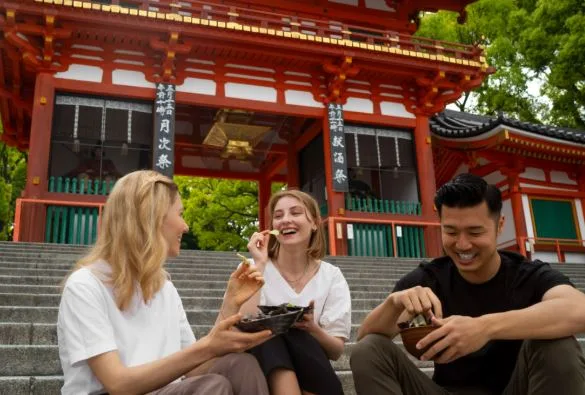How Tokyo Food Tours Transform the Way You Experience a City
Standing at the intersection of tradition and innovation, most travelers to Tokyo face a peculiar paralysis. The city sprawls before them with over 160,000 restaurants, each promising something extraordinary, yet they find themselves repeatedly drawn to the same familiar chains or hotel recommendations. This isn’t about hunger. It’s about the deeper human fear of missing what matters, of leaving without truly understanding the soul of a place that has captivated the world’s imagination for centuries.
A Tokyo food tour addresses something more profound than simply filling your stomach or checking boxes on a must-eat list. It represents a fundamental shift in how we engage with foreign cultures, moving from the role of distant observer to active participant. When you follow a local guide through the narrow alleys of Tsukiji Outer Market or the lantern-lit paths of Omoide Yokocho, you’re not just tasting food. You’re receiving an invitation into the intimate rhythms of daily Japanese life, the unspoken rules of etiquette, the stories behind century-old family recipes, and the philosophical approach to craftsmanship that transforms simple ingredients into transcendent experiences.
The Psychology Behind Culinary Exploration
The act of eating in an unfamiliar place triggers something primal in human psychology. We’re simultaneously vulnerable and curious, opening ourselves to new sensations while navigating the anxiety of the unknown. Research in cultural psychology shows that shared meals create stronger bonds between strangers than virtually any other social activity, releasing oxytocin and building trust through the universal language of breaking bread together. Food tours capitalize on this neurological reality, creating accelerated intimacy between travelers and local culture.
What makes this transformational rather than merely transactional is the framework of meaning that guides provide. Instead of wandering aimlessly through department store food halls, overwhelmed by choices you can’t decipher, you gain context. You learn why the woman behind the tamagoyaki stand has been perfecting her egg technique for forty years, what it means when a sushi chef places wasabi in a particular position, or how the post-war black market evolved into the vibrant Ameya-Yokocho district. These narratives transform random consumption into meaningful connection, rewiring how your brain processes foreign experiences.
The cognitive load of navigating a foreign food culture alone is exhausting. Menu kanji becomes indecipherable, ordering systems feel like puzzles, and the fear of committing social faux pas keeps many travelers in their comfort zones. A guided experience removes this barrier, freeing mental energy for actual appreciation rather than survival-mode problem-solving. This mental shift is precisely what allows transformational travel experiences to take root.
Discovering Tokyo Through Neighborhood Stories
Tokyo isn’t a single entity but rather a collection of distinct villages, each with its own character, history, and culinary identity. Understanding this fundamental truth changes everything about how you experience the city. The businessmen’s yakitori alleys of Yurakucho tell a completely different story than the artisan chocolate shops of Jiyugaoka or the standing sushi bars of Shibuya. Each neighborhood represents a different facet of Tokyo’s complex personality, and food becomes the key that unlocks these distinct worlds.
Walking through Asakusa’s traditional streets while sampling ningyo-yaki cakes, you’re not just eating sweets shaped like lucky gods. You’re touching a thread that connects modern Tokyo to the Edo period entertainment district it once was, when kabuki actors and geisha walked these same paths. The food carries memory, and eating it with someone who can articulate that memory transforms you from tourist to temporary resident, someone who glimpses the layered history beneath the contemporary surface.
The Tsukiji Outer Market experience exemplifies this perfectly. While the famous inner wholesale market relocated to Toyosu, the outer market’s labyrinth of specialty shops continues to serve as Tokyo’s culinary heart. Here, third and fourth-generation shopkeepers maintain relationships with restaurants across the city, sourcing ingredients with the kind of obsessive specificity that defines Japanese food culture. When you taste fresh uni directly from a vendor who has been selecting sea urchins for thirty years, you’re not just experiencing premium seafood. You’re witnessing a living philosophy of craftsmanship, where mastery comes from a lifetime of dedicated focus on a single element.
Local tour operators have built their reputations on revealing these deeper layers, connecting travelers with guides who don’t just know where to eat but can articulate why certain places matter. Choosing a tokyo food tour that focuses on local food adventures and cultural immersion takes you to hidden taverns and neighborhood restaurants where genuine connection happens naturally. For those seeking deeper exploration of Japanese drinking culture, specialized experiences like sake tasting with certified experts or discovering hidden ramen shops beloved by locals offer pathways into understanding the philosophy behind each bowl and bottle. This intimate approach matters because the transformational potential of food tourism depends entirely on the quality of human connection it facilitates, whether you’re exploring sake bars in Shinjuku or discovering century-old shops in quieter districts.
The Art of Eating as Cultural Education
Japanese food culture operates on principles that most Western travelers have never encountered. The concept of “ichigo ichie,” roughly translating to “one time, one meeting,” infuses even casual dining with mindfulness. Each meal is understood as a singular moment that will never be exactly replicated, deserving full presence and appreciation. This philosophical framework transforms eating from mechanical fuel consumption into meditation.
Learning to recognize these cultural subtleties changes how you move through the world. You begin noticing the seasonal awareness built into every menu, the way autumn brings matsutake mushrooms and winter demands warming nabe hotpots. You understand that the minimalist presentation isn’t about deprivation but rather about honoring the inherent beauty of ingredients. The chef who serves you three perfect pieces of sashimi isn’t being stingy; they’re practicing restraint as an art form, believing that less allows more appreciation.
The educational component extends beyond food itself into broader social dynamics. You learn the etiquette of sitting at a counter versus a table, when to say “itadakimasu” and “gochisousama,” how to hold chopsticks properly and why slurping noodles is actually good manners in Japan. These aren’t arbitrary rules but expressions of deeper values around respect, gratitude, and social harmony. Mastering them, even temporarily, provides a window into the Japanese worldview.
Building Confidence Through Guided Experience
Perhaps the most overlooked benefit of food tours is the confidence they build for independent exploration. After spending several hours with a knowledgeable guide, you’ve absorbed not just specific restaurant recommendations but a mental map of how to navigate Tokyo’s food scene. You’ve learned to recognize the plastic food displays in windows, understand the ticket machine systems at casual eateries, and identify the visual cues that distinguish different types of establishments.
This confidence is transformational because it converts anxiety into agency. Instead of spending your remaining days in Tokyo paralyzed by choices or retreating to familiar territory, you venture into neighborhoods alone, try restaurants without English menus, and engage with shopkeepers using your newly learned phrases. The fear of the unknown transforms into curiosity, and that psychological shift defines the difference between tourists who skim the surface and travelers who genuinely connect with a place.
The ripple effects extend beyond your Tokyo visit. Having successfully navigated one of the world’s most complex food cultures, you approach future travel differently. You seek local guides more readily, invest time in understanding cultural context, and recognize that the most meaningful travel experiences require vulnerability and willingness to be guided by those who call a place home. Tokyo becomes a reference point for how travel can be both adventurous and educational, pleasure-seeking and transformative.
Creating Memories That Reshape Perspective
Years after returning home, what remains isn’t the Michelin stars or Instagram photos but the human moments. The elderly tempura chef who explained his oil temperature philosophy through gestures and broken English. The jazz bar owner in Kichijoji who shared sake while playing vinyl records from his personal collection. The market vendor who insisted you try three different types of mochi because she wanted you to understand the textural nuances between them.
These moments of generosity and connection reshape how you think about travel, hospitality, and human connection across cultural boundaries. They remind you that beneath the surface differences of language and custom, the desire to share what we love and welcome strangers into our world is universal. A well-designed Tokyo food tour creates the containers for these moments to unfold naturally, turning a city of millions into a series of intimate human encounters.
The transformation is complete when you realize Tokyo has given you not just memories but a new lens for seeing the world. You notice craftsmanship differently, appreciate seasonal awareness more deeply, and approach foreign experiences with greater openness. The food was never really the point—it was always about using food as the vehicle for profound cultural exchange and personal growth.





